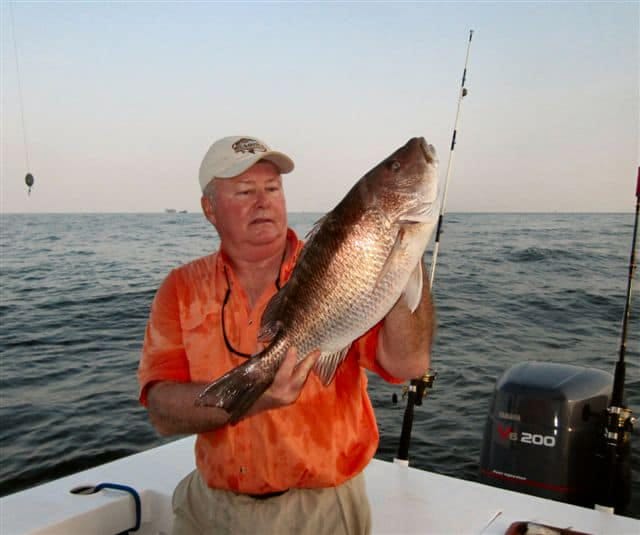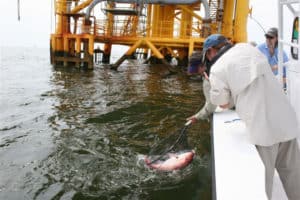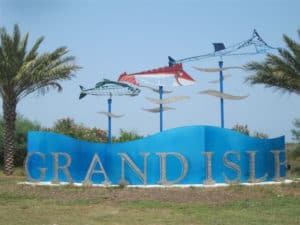by Bob McNally
We hadn’t fished but just a few minutes, and the stout-action rod Scott Gardner was holding bent double. There was no need for Scott to set the hook, just start cranking and try to keep whatever fish it was away from the line-cutting potential of an oil rig we were tied to.
The fish battle sea-sawed for long minutes, but Gardner finally got the upper hand, horsing the fish away from the towering rig beside us.
A few minutes into that fight, another of our crew, Ed Mashburn, grunted as his rod bowed heavily as he fought a second fish. Then Al Ristori followed with yet a third fish, and soon I was hooked to something big and deep and running far and fast.
The complete chaos of four big saltwater fish simultaneously fought from a 27-foot open boat beside a big oil rig is difficult to describe without it sounding overstated. But it was complete piscatorial pandemonium as our lines cross, reel drags screamed, anglers hooted and hollered, grunted and groaned, and our guide Capt. Mike Scardino worked hard to keep some degree of order among his fishing crew.
We lost one of the four fish at boat side in clear Gulf of Mexico water. It was a heavy mangrove snapper we estimated weighed 10 pounds, and Ristori laughed when the fish pulled free. Garner’s fish was a 20-pound red snapper. Mashburn landed a bull red drum, an estimated 30-pounder that was released. Mine was a 20-pound cobia that we kept for eating.
And the good fishing was just starting.
The next several hours became kind of a blur, as the fish fighting, hooking, re-rigging, landing, and releasing was virtually non-stop. And the wide variety of fish species caught was remarkable.

Mangrove snapper action is excellent, and they’re big, as shown by this 10-pounder held by author Bob McNally.
Using whole dead menhaden baits, also known as pogies, we caught spotted seatrout, weakfish, ladyfish, 100-pound class sharks, lane snapper and likely some other fish species I’ve overlooked.
Our primary targets were large red snapper, and our crew of six anglers put a dozen of those fish, an easy limit, in the boat in short order. All were at least 12 pounds, and several fish weighed 20. The mangrove snapper limit was five per person, and we had nearly that number before heading back to shore. None weighed less than 5 pounds, most were close to 10 pounds.
Additionally there were cobia, sea trout, weakfish, and a couple smaller (though delicious eating) lane snapper.
The 150-quart cooler that Capt. Scardino uses as an on-boat fish box was filled, and we had to press into service another 100-quart cooler to hold more of the catch.
And we were done fishing, heading back to our port of Grand Isle, Louisiana by noon.
THAT is good fishing, and indeed it was by far the best snapper action I’ve ever experienced anywhere.
But you don’t get to Grand Isle by accident. It’s a small fishing village with a population of just 1,500 at the farthest reaches of Louisiana Highway 1, smack dab in the southern mid-coast of the state, completely surrounded by saltwater.
As the crow flies, Grand Isle isn’t so vary far from New Orleans, maybe 75 miles south. But the road from New Orleans winds west and south, and then east, and treks across bayous and bays for more than 100 miles before reaching Grand Isle.
Such isolation from the trappings of modern life makes for few visitors. And most of them are fishermen, since the place surely ranks as one of America’s great angling destinations. Grand Isle not only is remarkable in the quality of its angling, but also the variety of fishing that can be found in the nearby area.
The labyrinth of bays and bayous, marshlands and tidal rivers east, west and north of Grand Isle are rich in shrimp, crabs and oysters. And this marine life base results in some of the most fertile fisheries in the world. Red drum (redfish) and spotted seatrout fishing in this region is world class, and anglers regularly catch five-fish limits of reds per day and 25-fish limits of seatrout.
If big-water, big-fish action is your passion, offshore fishing around the hundreds of area oil rigs is outstanding, since the rigs act like giant artificial reefs in attracting fish. Snapper action is world class, as described earlier. In addition hard-fighting cobia are abundant around oil rigs. Farther offshore amberjacks, grouper, and king mackerel are common.
Trollers working even deeper water catch giant yellowfin tuna pushing 200 pounds, wahoo half that size, plus blackfin tuna, dolphin and even blue marlin.
While anglers who have their own boats, motors and skills can trailer their craft to Grand Isle and fish on their own, hiring a guide is recommended, at least for fishermen new to the region. The area has a wealth of excellent native captains and guides who know the area like you know your backyard. Guides and charter boats are available for virtually everything ranging from snapper and bottom fishing to inshore action for trout and redfish, to rig fishing for cobia and trolling for tuna and others.
Fishing can be great year-round, but summer through early autumn, and spring, are prime.
Capt. Mike Scardino charters his 27-foot aluminum center console, Hard Times for snapper, cobia, kingfish and other species. He’s also the contact man for anglers wanting seatrout, redfish and offshore trolling action, too. Capt. Scardino can be reached at (985) 787-3529.
Motels and restaurants catering to fishermen are on the island, including the Sand Dollar Motel, where we stayed in quiet comfort within walking distance of restaurants and a full-service marina.
The Grand Isle Tourist Commission is a good contact for visiting anglers wanting information on facilities and guides. Go to www.townofgrandisle.com or call (985) 787-2997.
The Union Sportsmen’s Alliance website is designed to provide valuable articles about hunting, fishing and conservation for members of AFL-CIO affiliated labor unions and all sportsmen and sportswomen who appreciate hunting and fishing and want to preserve our outdoor heritage for future generations. If you would like your own story and experience from the outdoors to be considered for our website, please email us at USAmembers@unionsportsmen.org.





